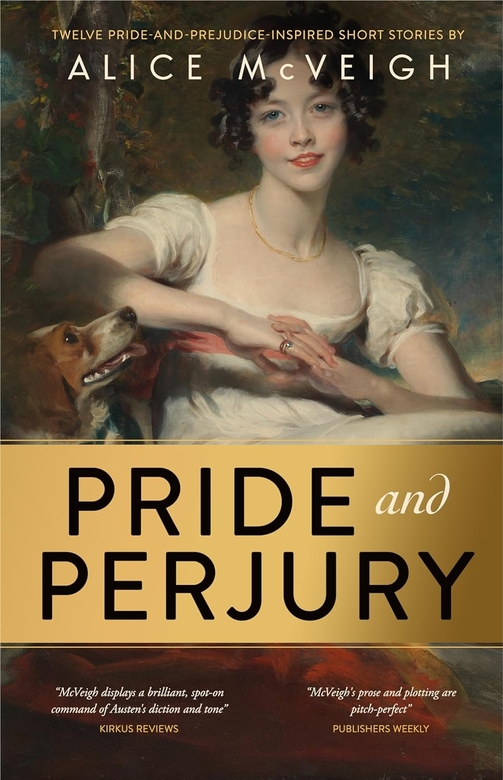
Exploring and expanding the already rich world of Jane Austen and her unforgettable cast of characters, Pride and Perjury: Twelve Short Stories inspired by Pride and Prejudice by Alice McVeigh is a freshly imagined collection of blushing stories from the lives of the Bingleys, Darcys, Bennets and more. From sisterly scheming and lovestruck lads come courting to golden-tongued gossip and eminently polite betrayals, these narrative offerings are classic examples of Regency romance.
“One Good Sonnet” is a particularly charming tale, detailing the obsessive devotion of one Paul Perkins Esq. – a suitor for Miss Jane Bennet. Brimming with sharp banter and flowery affections, along with musings on poetry, courtship, and the politics of marriage, this story nestles neatly within the established literary world of the Bennets. Demonstrating both the petty nature of courtship competition and the superficial foundation of infatuation, this piece highlights hypocrisy and social snobbery in an offhand way that could come straight from Austen’s pen.
“The Bennet Girls’ Easter Bonnet” is another standout story, made more pleasurable by readers’ foreknowledge that Mr. Darcy and Elizabeth will eventually get together, despite the uncertainty of the piece. The narrative reminds readers how fragile and tentative romance could be in a time of long journeys and delayed correspondence, when miscommunication could upend an entire courtship, or a whispered word in the right parlor could shake local power. This delicate dance of etiquette and custom is juxtaposed with the childish conflicts of the Bennet sisters, and the use of whimsical symbols as storytelling tools. A whirl of perspective and subject matter shifts also keeps readers on their toes, hinting at the deeper levels of meaning behind every casual conversation and seemingly inconsequential decision.
The more impressive stretches of prose uniquely echo Austen’s spirit of wit and incisive commentary on class, gender roles, family duty, and a striated society, but there are a few stories that attempt to do too much, as though the author wanted to squeeze in more elbow jabs and Shakespearean twists than necessary, which doesn’t always work in the shortened medium. In terms of technical accuracy, however, McVeigh does an impressive job with consistency in colloquial phrasing and Regency-era style. Writing consistently at such heights of formality is a careful art, but McVeigh spins a marvelous illusion through narrative voices ranging in age, temperament, gender, and social standing.
For lovers of Jane Austen’s work, there is no shortage of spinoffs and fan fiction, but it takes more than pomp, circumstance, and some dextrous wordplay to emulate a master. McVeigh’s depth of familiarity and knowledge with this world is complete, allowing both new and old characters to add spectra of color and emotional nuance to this well-loved canon. Readers who may not be experts in Austen’s world can still appreciate these tightly wound tales and lyrical prose, but long-time fans will benefit from the easter eggs and overlapping storylines that come to light in these pages.
Demonstrating an eloquent passion for Regency-era writing and an ongoing commitment to expanding Jane Austen’s world, this collection is a smartly crafted and entertaining homage, which does more than justice to the source material.
Book Links
STAR RATING
Design
Content
Editing
Get an Editorial Review | Get Amazon Sales & Reviews | Get Edited | Get Beta Readers | Enter the SPR Book Awards | Other Marketing Services























Leave A Comment